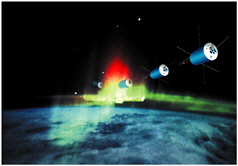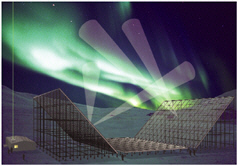THE THRESHOLD OF SPACE
EARTH’S UPPER ATMOSPHERE
At an altitude of approximately 80 kilometers, some of the electrically neutral atoms and molecules of Earth’s thin upper atmosphere are ionized by the Sun’s ultraviolet and x-ray radiation, creating the ionosphere. This is not really a separate layer of the atmosphere, but rather a population of electrons and ions that are mixed in with the neutral gas of the thermosphere. It is the ionosphere that makes long-distance radio communication possible, since it acts as a kind of mirror in the sky, bouncing electromagnetic signals back down to Earth, over the horizon from their point of origin. At Earth’s high northern and southern latitudes, intense current systems link this ionospheric plasma with the plasmas of the magnetosphere and channel energy from the magnetosphere into the upper atmosphere. What happens to this energy—whose source is ultimately the solar wind—once it is deposited in Earth’s upper atmosphere? Some of it powers the northern and southern lights, some of it goes into heating the upper atmosphere, and some of it drives thermospheric winds with speeds as great as 1,000 meters per second. Disturbances in the ionosphere can result in disruption of radio communications; and navigation signals beamed to Earth from Global Positioning System (GPS) satellites, high above the ionosphere at an altitude of 35,500 kilometers, can be degraded as they pass through disturbed regions in the ionosphere. Sun-Earth interactions can distort the ionospheric mirror and garble communications. Earlier studies have taught scientists much about the structure, energetics, and dynamics of the upper atmosphere. However, the different spatial and temporal scales on which magnetospheric energy is deposited and redistributed in this region are poorly known, as is the complex and ever-changing relationship between small-, intermediate-, and large-scale phenomena.
The Survey Committee assigns high priority to two initiatives, one space-based and one ground-based, that will employ novel investigative strategies

During the 2-year multispacecraft Geospace Electrodynamic Connections mission, “deep dipping” maneuvers will be performed to allow in situ measurements down to altitudes as low as 130 kilometers.
and techniques to study the transfer of energy between the magnetosphere and the upper atmosphere, and the processing of this energy within the upper atmosphere.
The Geospace Electrodynamic Connections (GEC) mission is a Solar Terrestrial Probe mission that will make simultaneous measurements from several spacecraft at different locations in the high-latitude ionosphere and thermosphere, a region not systematically sampled by spacecraft since the 1960s. Together with supporting ground-based observations, GEC will answer a number of outstanding questions about the coupling of the magnetosphere to the upper atmosphere and of the ionosphere to the thermosphere.
For ground-based geospace research, the Advanced Modular Incoherent Scatter Radar (AMISR) is the Survey

Artist’s concept of the portable Advanced Modular Incoherent Scatter Radar deployed at a high-latitude site to study the response of the upper atmosphere to auroral activity.
Committee’s top-ranked small initiative. It will combine a powerful state-of-the-art incoherent scatter radar with supporting optical and radio instrumentation. To maximize return on investment, and taking advantage of progress in the miniaturization of instruments, AMISR will be designed to be modular and mobile. AMISR can be deployed to different geographical locations and reconfigured to probe the upper atmospheric phenomena specific to each location. This unique capability will allow AMISR to investigate a wide range of ionospheric phenomena at polar, auroral, equatorial, and mid-latitudes, and to operate in close conjunction with other ground-based, suborbital, and satellite investigations of the geospace environment. Initially, AMISR will focus on the coupling between the neutral atmosphere and the ionospheric plasma in the auroral oval.


